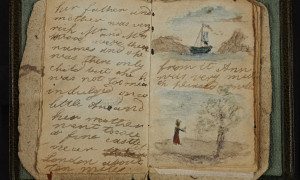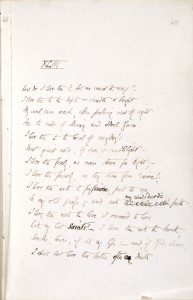Treasures from the British Library’s Digital Archives
[dropcap]A[/dropcap]fter finishing your exams, or perhaps even your degree, the idea of reading essays for fun may seem preposterous . However, the British Library’s new online resource Discovering Literature: Romantics and Victorians might just be an exception. Taking the “literary treasures” of these periods, the website uses essays, pictures and videos to open up and explore famous works by the likes of William Blake or Jane Austen.
[pullquote style=”right” quote=”dark”]It’s the sort of thing you could enjoy along with a cup of tea and a biscuit… honest![/pullquote] You have to hand it to the British Library, the visuals of the website are just gorgeous. My favourite part of the site is the “Themes” tab, which groups essays into subject areas from “Popular Culture” to “Romanticism” and illustrates them with photos that rival even the most cultivated Pinterest board.
Whilst themes such as “The Gothic” will always have a special place in my heart (John Mullan’s “The Origins of the Gothic” is an excellent essay that muses on the roots of the genre), I particularly enjoyed the more unusual topics of “Childhood and Children’s Literature” and “Visions of the Future”. Indeed, children’s fiction is now a largely studied area in contemporary literature, but the essays on this website aren’t covering subjects as happy as Peppa Pig Goes to School. Given the context, the literature discussed in these essays often encompasses far more bleak subjects, such as stories of orphans (Jane Eyre, anyone?) and juvenile crime.
 The futuristic theme, however, is something that is so interesting to look at retrospectively, if not slightly hard to get your head around. I just love the images that illustrated La Vie électrique, featured in the article “Inventing the future”, a science fiction novel which tried to guess what the inventions of the mid-20th century would be. It’s so strange that they got certain things right.
The futuristic theme, however, is something that is so interesting to look at retrospectively, if not slightly hard to get your head around. I just love the images that illustrated La Vie électrique, featured in the article “Inventing the future”, a science fiction novel which tried to guess what the inventions of the mid-20th century would be. It’s so strange that they got certain things right.
Talking about the past and present, what I find most interesting about this resource is how, with the inclusion of images of the original manuscripts or editions of certain works, it allows the old and the new to complement one another rather than act as enemies. Since electronic formats were forged into the pastime of reading, the fear that the physical book will dissolve into the abyss has lingered in the background. The British Library’s site however, demonstrates how newer formats can actually bring the original manuscripts and novels back to the public eye.
 While you’re not going to get that forever quoted “old book smell” that library and bookshop dwellers will tell of (well, unless Google or Apple invent something for that), the physical form of rare texts is no longer limiting them from reaching more readers. Despite the fact that I’m still one who prefers her novels to be made of paper, there’s something refreshing about how you can view the crossing out on Elizabeth Browning’s “How do I love thee?”. Being able to see the mistakes and the drafting of these works reconnects you to the fact that the writers were human; it’s not just a sterile, typed up edition.
While you’re not going to get that forever quoted “old book smell” that library and bookshop dwellers will tell of (well, unless Google or Apple invent something for that), the physical form of rare texts is no longer limiting them from reaching more readers. Despite the fact that I’m still one who prefers her novels to be made of paper, there’s something refreshing about how you can view the crossing out on Elizabeth Browning’s “How do I love thee?”. Being able to see the mistakes and the drafting of these works reconnects you to the fact that the writers were human; it’s not just a sterile, typed up edition.
Especially considering that we are sometimes geographically constrained from exploring the original, physical texts, the online images of them brings something that we would have otherwise lost from the reading experience. When promised trips to the British Library never came to fruition in my secondary school life, this is indeed a happy medium for the public to enjoy – even outside of revision!
Highlights from the collection
> Eating and drinking in Alice’s Adventures in Wonderland (Theme: Childhood and children’s literature)
Although there are some grim facts about the terrible things they used to plump out food with, it’s oddly intriguing.
>Inventing the future (Theme: Visions of the future)
The pictures breaking up this article were the best bit for me – the way they pictorially represented industrialisation is amusing.
>Emily Bronte’s diary
My favourite item in the collection that they have listed is Emily Bronte’s diary, especially with its palimpsests and drawings.
Anything to do with Jack the Ripper sends shivers down my spine, so it’s even more eerie to see the news presented in an illustrated way like this.
Images: British Library
Comments